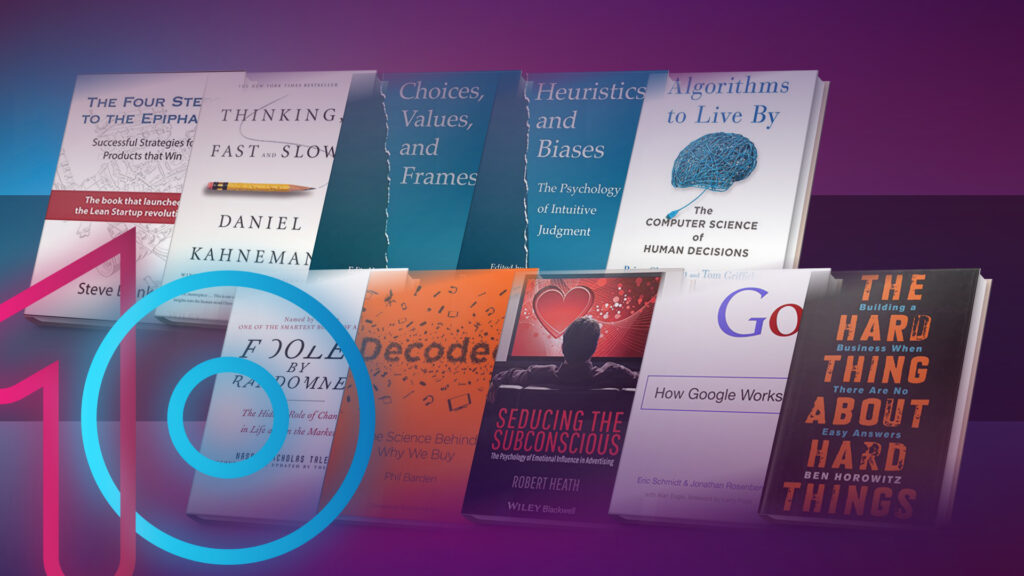Written by Olivier Tilleuil, CEO & Founder @ EyeSee
For clients, EyeSee is about scalable behavioral research. But building a company with 144 diverse talents means there’s much more to it. We started EyeSee exactly one decade ago and there was a lot of transformation and learning in the process. Here are 10 books (in categories such as startup, the idea, behavioral research, and growth) that helped and guided us to where we are today.

Check out the 4 chapters:
The lean startup and 4 steps to an epiphany (bonus Plan B)
Most innovations or startups don’t fail because of technology, they fail because of product-market fit. Our initial business plan was two pages long and fitted on one slide. The idea was simple: you make something that has a high impact (in our case, web-based eye tracking that measures gaze and is one of the conditions of purchases – ‘what is not seen is not bought’) and scalable – fast, cost-effective, and global.
Before EyeSee, all eye tracking research was done in a central location which is expensive ($50,000-$200,000) and time-consuming (6-8 weeks). Our goal was to have eye-tracking results in 2-3 days and at about 10% of the current price.
The client? Creative agencies. We provide them with the tools to make their ads more effective. The idea was pitched to two creative agencies. Feedback was the same; if we were able to provide eye tracking at the promised speed and cost, the agencies would test all the campaigns they have lined up. Great news! We then developed the product, and they haven’t tested a single campaign so far.
Which brings me to the first book, ‘The Lean Startup’, which is about the build, measure, learn. Client take is valuable, but until they use the product (and for that to happen, you need to build and invest in it), feedback is arbitrary. Our first Minimal Viable Product (MVP) was projected to take about 2-3 months to develop, yet we built it over the course of 2 weekends. Often the main discussion when working on MVPs comes down to the number of features. What I found to be the most helpful came from the author of ‘The Lean Startup’ (Eric Ries), who said: “You take your first idea for an MVP, then cut that in half, and cut it in half again – and there you got what actually is an MVP”. Startups typically have too many specs and wait too long to show the product to clients. It makes sense as founders tend to be passionate about the product; however, the process should not revolve around their expectations but rather around the client’s willingness to buy and how wide the market for the MVP is.
What did the first MVP look like in EyeSee? Almost the same as “Halo world”. We had a program running on Linux – you’d open the program, we’d show you the slides with instructions, you’d access the webcam, do the eye gaze calibration, and then we’d test by showing a couple of (randomized) images that changed every 7 seconds. Eye gaze was saved in .csv file with a time stamp, X and Y coordinate. For every ten sessions, about one worked. Good enough to test potential and show to first clients.
We quickly pivoted several times thanks to build-measure-learn; methodologies, solutions, and targeting of clients were tweaked. First, eye tracking was launched, and then we added facial coding (based on a request by one of the biggest Food& Bev companies in the world), followed by virtual shopping (that was requested by a large healthcare company). The market demand also impacted our product rollout – ads were first, followed by pack and e-commerce tests.
The book ‘The Four Steps to the Epiphany: Successful Strategies for Products that Win’ makes a case for an iterative approach and features useful examples.
The idea and the basics: statistics and social science (but especially psychology)
One of the frequently asked questions for new solutions is, “Where did the idea come from?”. Before EyeSee, I was on a Ph.d. trajectory in the field of Decision Science and Entrepreneurship. After the first conference in the field, I decided to quit. The papers and methodologies used were not fit for the research questions; on top of that, the sample sizes were too small. Disillusioned, I didn’t want to have anything with academics. One year after quitting, I saw an eye-tracking study and had three thoughts (a) that is interesting research – it is an objective measurement (no biases as in surveys or focus groups) and has a high impact (if shoppers don’t see the new pack design, shoppers won’t buy the product)… (b) too bad it is so expensive because of the central location, (c) what if we could do it with people’s own laptop and webcam to make it faster and cost-effective.
The interest in eye tracking comes with a fascination with consumer decision-making. As a tween, I once asked my mom how much she paid for items in her cart. She didn’t know any of the prices. Moreover, I am pretty sure my mom didn’t know whether the brand was relatively expensive or cheap. Decision science is rooted in psychology; why a particular decision was made and what influenced the choice – can be explained by sensory theory, learning mechanisms, etc.
My mom’s shopping choices are a good example of subconscious or so-called System 1 decision-making. Buying groceries is strongly influenced by the subconscious; if shoppers were to evaluate the cost-benefit of each product, they would spend hours per category. Looking at behavior in stores, shoppers spend closer to 7 seconds per category and scan products in a split second. If your product needs to win in a small window of time, a confusing five-claim pack design won’t do the job.
To better understand the processes behind decision-making in a straightforward way, ‘Thinking, Fast and Slow’ by Daniel Kahneman is a perfect read. You could also check out his earlier works with Tversky (e.g., ‘Choices, Values, and Frames’) or ‘Heuristics and Biases: The Psychology of Intuitive Judgment’, which are insightful, although much more dense and academic. As for the psychology field, basically, any introduction to psychology (incl. cognitive psychology) will provide a strong basis. My personal favorite and bonus recommendation is ‘On Intelligence’ – written by a computer scientist that provided an engineer-like perspective on how our brains work.
When it comes to good research, at the very core of it is statistics. Storytelling without a strong basis in statistical relevance can make you feel good but is more likely complete BS. Being knowledgeable in statistics helps you create decent research designs and determine appropriate sample sizes. However, this is one of the know-hows market researchers today lack the most. For HBS school examples, ‘Algorithms to live by’ or ‘Fooled by randomness’ are interesting starting points.
The business impact: decoded, seducing the subconscious, and growth
A lot of basic research approaches are not yet employed to address consumer insights (e.g., what matters for a pack design? What makes ads successful?). There are a couple of books that make the leap toward the shopper and ad effectiveness. One of them is ‘Decoded, the science behind why we buy’ and to none’s surprise, starts off with Daniel Kahneman’s System 1 and 2 theory. The following two examples illustrate the content of the book perfectly.

The left graph indicates that the color of the price tag can influence the perception of whether a product is low or high-priced (obviously, it will depend on competitive prices). On the right hand, you have 2 shapes of bottles; although they have the same volume, people perceive bottle A as the one with the higher volume. Good to know if the volume is an important driver in your category.
In ‘Seducing the subconscious’, Robert Heath expands more on the ‘Low Involvement Processing’ theory in advertising. The theory brought the notion of implicit processing to consumer research, in which rather than drawing explicit verbal conclusions, we process and store data through implicit associations – often without even realizing it (so-called low level of attention). The key to successful brands is the ad’s ability to tackle those implicit associations, rather than to create high awareness. This would explain why some brilliant advertising campaigns had bad performance results using methodologies based on articulation and statements. Moreover, Heath argues that some emotional elements of advertising can elude the defense mechanisms we use to filter ads and consciously redirect our attention toward something else.
You don’t necessarily need to agree or share the same perspective as the authors; for me, it is often about sparking your own creativity and mindset. Steve Jobs once said that if all people like your brand, you don’t have a brand.
I included ‘Seducing the subconscious’ as a must-read since it tackles the underexplored area in research: how do we leverage behavioral research for (real) strategic questions?
Growth: no-nonsense decision-making and organizational development
I’d recommend looking at ‘The Hard Thing About Hard Things: Building a Business When There Are No Easy Answers’ about action-oriented, down-to-earth decision-making with interesting examples. His writing can be related to fundamental principles, as one of the Amazon reviews pointed out: “Effectual reasoning has three main principles: the (1) a bird in the hand, which means understanding the resources that you have at your disposal, (2) crazy quilt, which means building from the bottom up with an end goal in mind, and (3) pilot in the plane, which means that you want to be in control but not always have all the information. In his book, Ben doesn’t talk explicitly about these principles, but he demonstrates them.”
Out of all challenges we faced over the years, probably the most difficult has been building an organization. EyeSee has the potential to become up to 10 times bigger, so how do we build and energize the organization to get there? “Power to the people” sounds great, but it is difficult and there are many necessary conditions to make it work. To address similar organizational challenges, I’d recommend taking a page out of ‘How Google Works’, which features some legendary catchphrases, such as ‘Don’t listen to the HiPPOs’, ‘the rules of seven’, ‘do all reorgs in a day’, ‘don’t look for faster horses’… Again, these are not a literal guide for implementation but as food for thought.
What I have learned in the past 10 years is that when you decide and act, you can’t know for sure if you are correct in advance. What is more important is how you deal with a situation that comes as a result and adjust to ensure a favorable ending. I hope the books above help you with that!
Interested in behavioral insights and innovation? Check out the top 10 behavioral studies that pushed the boundaries of consumer insights.
